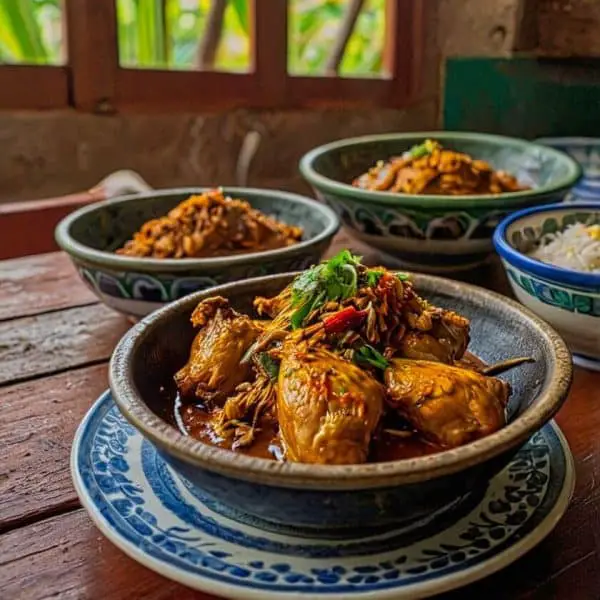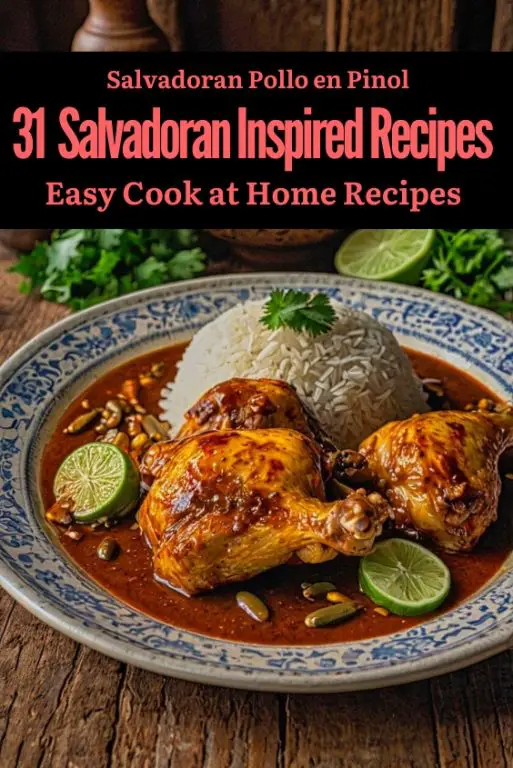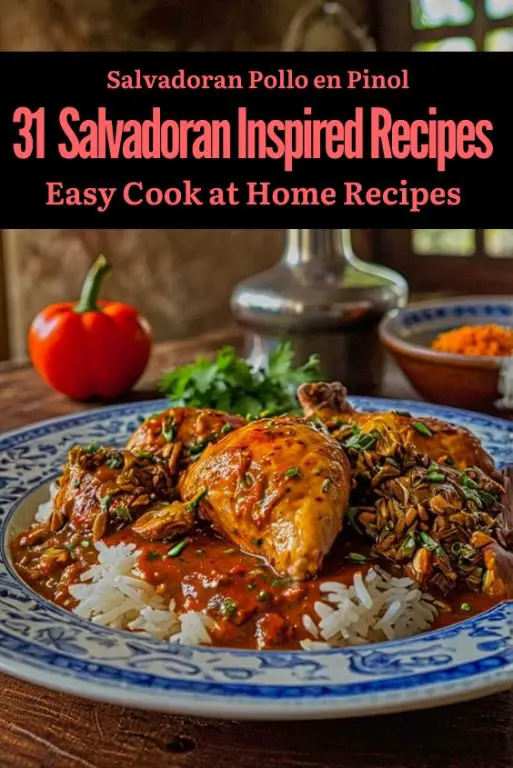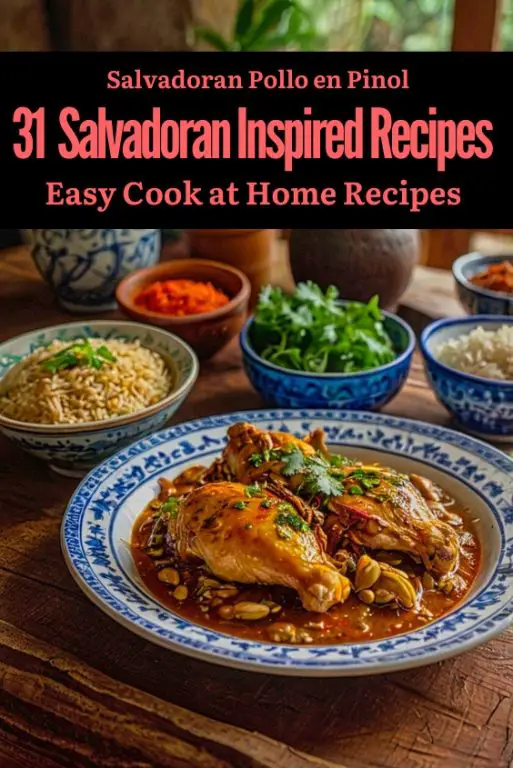Pollo en pinol is a Salvadoran recipe which calls for chicken in a sauce of vegetable, spices and Pinol (ground corn and nuts). The seasonality of ingredients is crucial when making Salvadoran Pollo en Pinol.
Tomatillos, cilantro, along with peppers for the sauce are generally at their peak in the hotter months.
Sourcing these ingredients whenever they’re in season benefits the dish’s taste, local growers and the carbon footprint of sending out-of-season produce is enhanced. For something more authentic, grab some fresh, in season tomatillos and herbs at your local farmers’ markets for a Pollo en Pinol upgrade.
Seasonality and cooking with organic ingredients may also affect the quality and flavor of your Salvadoran Pollo en Pinol. Organic and natural chicken grown with no antibiotics or hormones tends to make a much healthier meal. You can enjoy the full, complex flavors of the dish when you buy organic products while supporting earth – friendly farming practices. Biting into tender chicken smothered in the dark sauce you can tell it had been raised organic.
Sustainable farming also affects the ingredients of Pollo en Pinol. Farmers who practice crop rotation and polyculture have healthier soils and ecosystems. These methods produce better product – important for dishes like Pollo en Pinol in which the freshness of ingredients can truly show. Supporting farmers that practise sustainable agriculture means you have access to new and delicious ingredients to make food with.
Ingredients For the Salvadoran Pollo en Pinol Recipe
Bone-in and Skin-on Chicken Thighs
Pinol Nuts
Achiote Paste
Dried Oregano
Cumin
Salt
Black Pepper
Chopped Onion
Chopped Red Bell Pepper
Minced Cloves Garlic
Vegetable Oil
Chicken Broth
Masa Harina
Water
Salt
Cooking Instructions For the Salvadoran Pollo en Pinol Recipe
- In a small bowl, mix together the achiote paste, oregano, cumin, salt, and black pepper to make a marinade.
- Rub the chicken thighs with the marinade and let them marinate for at least 30 minutes, or overnight in the refrigerator.
- In a large pot or Dutch oven, heat the vegetable oil over medium heat. Add the chopped onion, red bell pepper, and garlic and cook until the vegetables are soft and translucent, about 5 minutes.
- Add the marinated chicken thighs to the pot and brown on all sides, about 5 minutes per side.
- Add the chicken broth to the pot and bring the mixture to a boil. Reduce the heat to low, cover the pot, and let the chicken simmer for about 30 minutes, or until the chicken is cooked through and tender.
- In a separate pot, mix the masa Harina, water, and salt to make the Pinol. Cook the Pinol over medium heat, stirring constantly, until it thickens and pulls away from the sides of the pot, about 10-15 minutes.
- Add the Pinol to the pot with the chicken and stir well to combine. Let the mixture simmer for an additional 10 minutes to thicken the sauce.
- Serve hot with rice and beans.
10 Ways to Eat Healthy in El Salvador
1. Select Fresh Fruits
El Salvador is filled with tropical Fruits like mangoes, papayas, bananas and pineapples. Additions of fresh fruit to your diet provide vitamins, fibre and antioxidants while enjoying the natural sweetness of local produce.
2. Consume More Beans
Beans are a staple in Salvadoran cuisine and an excellent source of plant based protein, fibre and minerals (magnesium and iron). Soups, rice or stuffed pupusas are other ways beans provide a filling meal and a source of energy.
3. Grilled Meats
In place of fried foods go for Grilled meats like Grilled chicken or carne asada. Grilling eliminates some added fat and is a balanced meal when paired with fresh veggies or a side of beans and rice.
4. Enjoy Fresh Salads
Salvadoran meals often feature Fresh Salads made with local vegetables. Including these in your plate gives you fibre, vitamins and minerals. For a nutritious side, eat salads with tomatoes, avocados and cucumbers.
5. Limit Fried Foods
While Fried Foods like Fried yuca and plantains are tasty, baked or grilled versions may be healthier. You can still get these foods without the extra oil and calories from frying.
6. Choose Whole Grains
When eating rice, choose brown rice over white rice if available. Brown rice has more fibre and nutrients so you feel full longer. Whole grains help with digestion and regulating blood sugar.
7. Go for Light Soups
Soups are a staple in Salvadoran cuisine, and traditional ones such as sopa de gallina or sopa de res contain vegetables and lean meats. Soups made from broth are lighter and more filling – without the extra calories.
8. Incorporate Seafood
El Salvador has long coastline and fresh Seafood is plentiful. Fish and shellfish offer lean protein and omega 3 essential fatty acids which help heart health. Grilled or steamed seafood dishes are healthy options.
9. Snack on Nuts and Seeds
Local Nuts and seeds such as cashews or pumpkin Seeds are healthy snacks. These snacks are full of good fats, fibre and protein – a great snack option to fill you up in between meals.
10. Drink Fresh Juices
Fresh fruit Juices are popular in El Salvador but can be high in sugar. Enjoy them moderately and choose whole fruits when possible. Or go with water or agua fresca (light fruit juice in water), a refreshing low-sugar drink.
FAQ For the Salvadoran Pollo en Pinol Recipe
Q: What ingredients are essential for the Pollo en Pinol recipe?
A: The Pollo en Pinol recipe is centered around several key ingredients that contribute to its unique flavor profile. The main ingredient is chicken, typically cut into pieces to ensure even cooking and absorption of flavors. The sauce, or “pinol,” is made from toasted cornmeal, which gives the dish its distinctive texture and nuttiness, along with ingredients like tomatoes, bell peppers, and spices such as cumin and coriander. Additionally, garlic and onion are often included to enhance the overall depth of flavor. This combination of ingredients creates a hearty and flavorful dish that is enjoyed in many Salvadoran households.
Q: How is the cooking process for the Pollo en Pinol recipe executed?
A: The cooking process for the Pollo en Pinol recipe involves several steps to achieve a rich and flavorful result. First, the chicken pieces are typically seasoned and browned in a pot, allowing them to develop a nice color and seal in the juices. Next, the pinol sauce is prepared by toasting the cornmeal and blending it with the sautéed vegetables, creating a thick sauce that will coat the chicken. Once the sauce is ready, it is combined with the browned chicken in the pot, and the dish is simmered until the chicken is fully cooked and tender. This method allows the chicken to absorb the flavors of the sauce, resulting in a delicious meal.
Q: What are some traditional sides to serve with Pollo en Pinol?
A: When serving Pollo en Pinol, pairing it with traditional sides can enhance the overall dining experience. A common accompaniment is rice, which serves as a neutral base that absorbs the flavorful pinol sauce, making each bite even more satisfying. You can also serve it with warm corn tortillas, perfect for scooping up the chicken and sauce. Additionally, a fresh salad made from crisp vegetables like lettuce, tomatoes, and cucumbers can provide a refreshing contrast to the rich flavors of the dish. These sides complement the Pollo en Pinol recipe well, creating a balanced meal that is both hearty and nutritious.
Q: How can I adjust the spice levels in the Pollo en Pinol recipe?
A: Adjusting the spice levels in the Pollo en Pinol recipe is straightforward, allowing you to tailor the dish to your taste preferences. If you prefer a milder flavor, you can reduce the amount of spices such as cumin and coriander or omit any hot peppers included in the recipe. Conversely, if you enjoy a spicier dish, consider adding diced jalapeños or a dash of hot sauce to the sauce for an extra kick. Another option is to serve the dish with additional hot sauce on the side, so each person can customize the heat level according to their liking. This flexibility makes Pollo en Pinol a dish that can appeal to a wide range of taste preferences.
Q: Can I make Pollo en Pinol in advance, and how should I store it?
A: Yes, you can make Pollo en Pinol in advance, making it a great option for meal prep or gatherings. After cooking, allow the dish to cool to room temperature before transferring it to an airtight container. It can be stored in the refrigerator for up to three days or frozen for longer storage, typically up to three months. When reheating, be sure to do so gently, either in the microwave or on the stovetop, to preserve the texture and flavor of the chicken and sauce. Preparing Pollo en Pinol ahead of time not only saves you effort on busy days but also allows the flavors to meld and develop further, often making it even more delicious when served later.

Salvadoran Pollo en Pinol
Equipment
- Large pot or Dutch oven for cooking the chicken
- Small bowl for making the marinade
- Knife and cutting board for chopping vegetables
- Wooden spoon or spatula for stirring
- Large pot for making the pinol
- Whisk for stirring the pinol
Ingredients
- 2 lbs chicken thighs bone-in and skin-on
- 1 tbsp achiote paste
- 1 tsp dried oregano
- 1 tsp cumin
- 1 tsp salt
- ½ tsp black pepper
- 1 onion chopped
- 1 red bell pepper chopped
- 3 cloves garlic minced
- 2 tbsp vegetable oil
- 3 cups chicken broth
- 2 cups masa harina
- 3 cups water
- 1 tsp salt
Instructions
- In a small bowl, mix together the achiote paste, oregano, cumin, salt, and black pepper to make a marinade.
- Rub the chicken thighs with the marinade and let them marinate for at least 30 minutes, or overnight in the refrigerator.
- In a large pot or Dutch oven, heat the vegetable oil over medium heat. Add the chopped onion, red bell pepper, and garlic and cook until the vegetables are soft and translucent, about 5 minutes.
- Add the marinated chicken thighs to the pot and brown on all sides, about 5 minutes per side.
- Add the chicken broth to the pot and bring the mixture to a boil. Reduce the heat to low, cover the pot, and let the chicken simmer for about 30 minutes, or until the chicken is cooked through and tender.
- In a separate pot, mix the masa harina, water, and salt to make the pinol. Cook the pinol over medium heat, stirring constantly, until it thickens and pulls away from the sides of the pot, about 10-15 minutes.
- Add the pinol to the pot with the chicken and stir well to combine. Let the mixture simmer for an additional 10 minutes to thicken the sauce.
- Serve hot with rice and beans.





3 comments
The Salvadoran Pollo en Pinol Recipe had such a unique and rich flavor. The chicken was tender, and the sauce, made from ground roasted corn and pine nuts, added to the taste.
I cant believe they left out the secret ingredient for Pollo en Pinol! And who knew there were 10 ways to eat healthy in El Salvador? Time to spice up my cooking game!
I cant believe they didnt include a vegan version of the Pollo en Pinol recipe! Come on, lets get creative with some plant-based alternatives. Whos with me on this culinary adventure? 🌱🍲